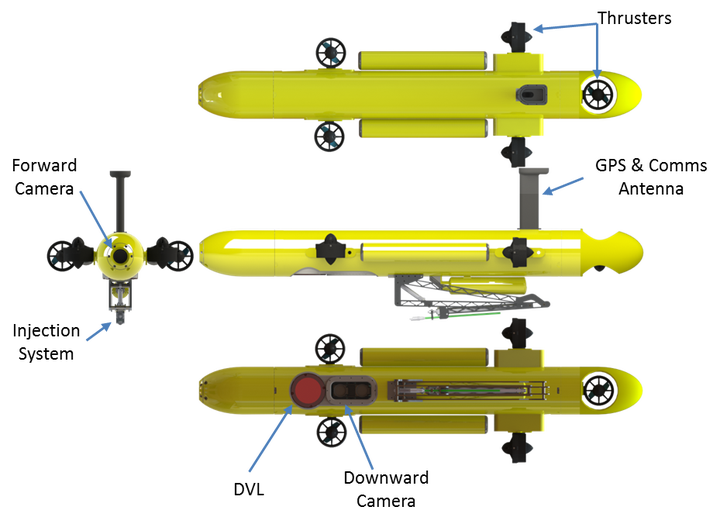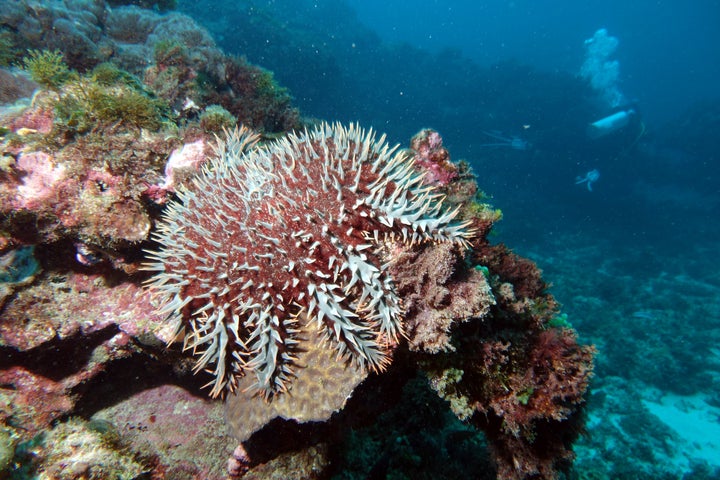
A roboticist at the Queensland University of Technology taught the lethal COTSbot how to identify a particular species of coral-eating starfish by showing its computer system thousands of images and videos. The super-smart bot is designed to navigate the Great Barrier reef, find the starfish and help bring the creature's population back under control so the reef can recover from the damage it's caused so far.
A killer robot might just be the hero the Great Barrier Reef needs to protect it from a booming population of coral-eating creatures.
As the crown-of-thorns starfish (COTS) ravages the famed Australian reef, a team of researchers has designed a search-and-destroy bot to deliver lethal injections and bring the COTS population back down to a manageable level.
Researchers at the Queensland University of Technology later this month will send their so-called COTSbot on its first hunt for live starfish at the reef. If successful, the robot could replace human divers as the first line of defense for controlling COTS outbreaks and, when deployed in fleets of 10 to 100, could cover more ground -- day or night and under any weather conditions -- than the divers who are sent to manually inject the starfish.
The submersible robot uses a combination of cameras, GPS, sensors and thrusters, along with starfish-detecting software, to identify the COTS among the coral. Once it finds its target, the COTSbot uses an extendable arm to reach down and deliver a single injection of bile salts, which should kill the starfish without harming the surrounding reef's fragile environment. The robot is designed to search the reef for up to eight hours at a time and can deliver more than 200 lethal injections, one per starfish.
Feras Dayoub, a roboticist at the university who designed the software, spent months training the COTSbot to differentiate between these particular starfish and other sea life by showing it images and videos of the reef.
"The system has seen thousands of images of COTS and not COTS," Dayoub told the Australian Broadcasting Company. "Now it's able to detect and decide which one is COTS and which one is not."
When their population numbers are low, the venomous COTS, which are native to Australian and Indo-Pacific reefs, can actually help increase coral diversity by consuming coral. However, when their populations spike -- possibly due to runoff from land during wet seasons -- the starfish consume coral faster than it can grow and have devastating impacts on reef habitats.
Between 1985 and 2012, researchers observed a 50 percent decline in the coral cover across the Great Barrier Reef -- COTS were said to be responsible for nearly half that decline. In 2015, 18 percent of the reefs surveyed had active COTS outbreaks, according to a study by the Australian Institute of Marine Science.

The crown of thorns starfish is native to Australia and the wider Indo-Pacific. It preys on coral polyps and is currently one of the main threats to the Great Barrier Reef. Every few years the starfish population explodes, fueled by nutrient-rich runoff from farming land in Queensland which allows the larval stage of the animal to feast on algal blooms. The crown of thorns has few natural predators, thanks to it's covering of sharp venomous spines.
Previously, divers culled the starfish's populations by diving down to the Great Barrier Reef and administering the injections by hand at targeted sites. But, says Matthew Dunbabin, one of the robot's creators, "there just aren't enough divers to cover all the COTS hotspots across the Great Barrier Reef."
"We see the COTSbot as a first responder for ongoing eradication programs deployed to eliminate the bulk of COTS in any area, with divers following a few days later to hit the remaining COTS," Dunbabin, a roboticist for the university's Institute for Future Environment, said in a statement.

When the COTSbot successfully identifies a crown-of-thorns starfish, its extendable arm delivers a lethal injection to the creature. The bot's complex software system is designed to help it avoid disturbing the surrounding ecosystem.
The deadly robot completed its first round of sea trials last week. When researchers send it on its first hunt for living targets later this month, it will photograph all of its potential kills so that they can first be verified by a human.
"We've done six months of hardcore training on this system and the reliability is astronomical," Dunbabin told ABC. "The data we get [during the next trial] will be used to refine our system. It's very robust now but it will be even better when it's finished."
The COTSbot will also continue to learn from its experience while it works in the field, Dayoub said in a statement.
"Its computer system is backed by some serious computational power so [it] can think for itself in the water," Dayoub said.
Below, preview the COTSbot's killer technology as its software identifies crown-of-thorns starfish among the coral.
See the beauty of the Great Barrier Reef below:

